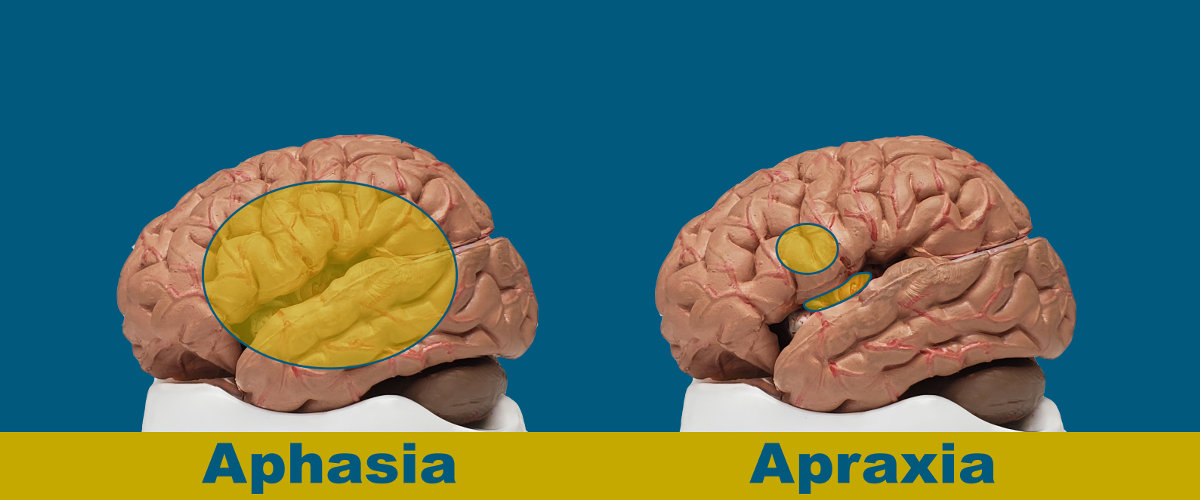
Aphasia and apraxia are different disorders that usually have similar causes. Someone who’s had a left hemisphere stroke or brain injury can have both aphasia and apraxia or aphasia without apraxia. There is some debate amongst researchers that apraxia without aphasia is technically possible, although my experience has not supported this argument.
Aphasia is the result of damage to some part of the left hemisphere of the brain. This means that the person had developed normally, but then something happened that caused the aphasia. The type of aphasia largely depends on the location of the stroke/brain damage. How severe the aphasia is largely depends on how large the brain area affected, but can also be the depth of the damage.
Physical issues also depend on the part of the brain affected. Each hemisphere of the brain is in charge of both motor and sensation for the opposite hemisphere. So you may see someone with aphasia who has physical deficits on their right side. These deficits can be one or more of the arm, face, or leg and can restrict movement, sensation, or both.
Aphasia affects language skills to different degrees. Language skills are reading, writing, understanding, and speaking. Anything that is language is affected — saying your alphabet (speech), reading a book (reading), texting (writing), understanding questions (comprehension). These are just a few examples, but there are hundreds. Depending on the type and severity of the aphasia, some language skills are more affected than others, but they are all affected.
Apraxia affects motor speech production. This means that if someone with aphasia can think of the words they want to say, the part of their brain that coordinates the movements to say those words gets a fuzzy signal or no signal at all. We don’t often think about all of the movements we use to say a word — we heard it or saw it, understood the rules, and then said it.
However, there are a lot of movements that have to happen very quickly to make sounds that then join with other sounds to become a word. For example, your jaw has to move (or not), your tongue has to move around, your vocal folds have to vibrate (or not), and your lips have to move (or not). Sometimes we also have to have our noses involved to make sounds like “mmmm” so that it doesn’t sound like we have a cold.
Here’s an example. To say the word “cat”, you have to sequence these movements quickly:
“C” (K sound) — open your jaw a bit, quickly pull the back of your tongue up, and turn your vocal folds ‘off’, hold your lips neutral, THEN
“A” (short A sound) — open your jaw a bit wider, flatten your tongue more, turn vocal folds ‘on’, hold your lips neutral, THEN
“T” (T sound) — close your jaw more, quickly move your tongue tip behind your teeth, tap your tongue and release quickly, hold your lips neutral, turn vocal folds ‘off’ again. up behind your teeth
This is a lot to coordinate when your brain can’t recall when to move what part and where. Now imagine that you want to say a longer word, such as ‘computer’ that has many syllables. You now have to sequence AND emphasize one syllable but not the others. Your brain will randomly change the sound you are trying to make because it can’t figure out how to make the correct one and control it. Then you have to start all over each and every time you want to sequence those sounds. It can take a lot of time, practice, and the correct approach to improve.
Apraxia and non-fluent aphasia are related, but you can have non-fluent aphasia without apraxia. There are different profiles of apraxia, just like there are different types of aphasia. Apraxia, however, requires that the brain damage be located in a very specific part of the brain. This area is right next to the area that results in non-fluent speech, such as Broca’s aphasia. (Apraxia can also result from damage to the insula, a cortical area in that same area but deeper). Therefore, you cannot have a fluent aphasia and apraxia, because fluent aphasia (Wernicke’s, conduction, anomia) is the result of damage to a different part of the brain. Treatment for speech in fluent aphasia is very different than treatment for apraxia because there are completely different causes for the speech errors.
